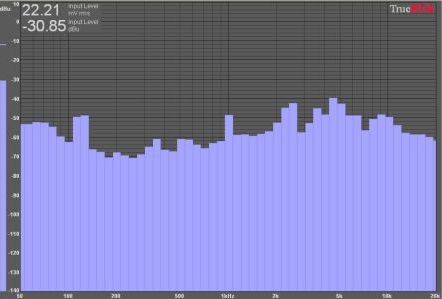
The RTA measurement system is a parallel bank of bandpass filters, driven with the signal to be analyzed. The filters have a bandwidth that is equal per for each filter The outputs of the filters are then displayed in bar-graph form. The filters are at fixed frequencies normally from 20 Hz to 20 kHz.
ANSI-ISO preferred frequency table:
25Hz, 31.5Hz, 40Hz, 50Hz, 63Hz, 80Hz, 100Hz, 125Hz, 160Hz, 200Hz, 250Hz, 315Hz, 400Hz, 500Hz, 630Hz, 800Hz, 1kHz, 1.25kHz, 1.6kHz, 2kHz, 2.5kHz, 3.15kHz, 4kHz, 5kHz, 6.3kHz, 8kHz, 10kHz, 12.5kHz, 16kHz, 20kHz

The RTA is commonly used with a random-noise to measure a system's response. The most common random noise signals are Pink Noise and White Noise.
White noise contains equal energy at all frequencies, it has an equal energy per hertz of bandwidth. If it is measured with an RTA, the spectrum will rise at 3 dB per octave. Pink noise is random noise that has an equal energy per octave. If it is displayed on an RTA, the response will be flat.
Pink noise is random noise that has equal energy per octave instead of equal energy per frequency like white noise. In other words, its energy is equal to 1/f, which is a -3dB/octave response. Each octave of increasing frequency contains half the power of the preceding one.
If it is displayed on an RTA, the response will be flat.
The problem with an RTA is that it is time-blind. It analyzes all signal components that arrive at the measurement microphone and average them.
In opposition to that, a time gated measurement system like TEF, MLSSSA, Smaart or Meyersound SIM can look at a particular slice of time. That could be the direct sound from a loudspeaker without reflections from a wall, etc. The measurement window is open only for a limited amount of time (some msec). The accuracy of the measurement is frequency-depending. A lower frequency needs a longer time window because of the longer wave length but here already first room reflections can 'dirty' the measurement in the higher frequency range.
The frequency resolution can not be better than the frequency that corresponds to the length of the measurement time window. For example, a time window of 2 msec corresponds to a frequency of 500 Hz (wave length). It limits the lower extent of the measurement to 500 Hz and allow to much content go into the measurement at higher frequencies. The best choice is a system like the Meyersound SIM, that has multiple time windows for different frequency ranges. But these systems are naturally also the most expensive ones. A system based on only one time window cannot be as precise as a system with multiple time windows.
Because of the time window measurement, a psycho-acoustically much more accurate measurement result can be achieved. With an RTA, the actual measurement and the psycho-acoustical perception of the received sound are different. Phenomenons like the Haas-Effect produce a certain imagination in our brains, because the brain is actually fooled. A measurement system with a time window don't even 'see' these effects because it measures only the first sound arrival. An RTA measures everything that arrives and mixes the direct sound and all reflections, whatsoever, into a time-independent 'measurement mix'.
Used in the right way, knowing the limitations, an RTA can still be a very helpful tool for fast measuring system responses and room resonances.